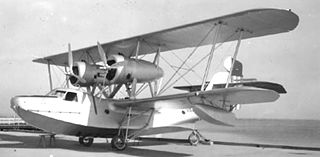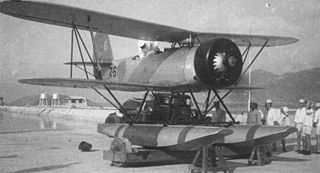
The Heinkel He 50 was a German World War II-era dive bomber, originally designed for the Imperial Japanese Navy. Serving in Luftwaffe prewar dive-bombing units, the He 50 served until almost the end of World War II as a night harassment bomber.

The Heinkel He 72 Kadett ("Cadet") was a German single-engine biplane trainer of the 1930s.
The Arado W 2 was a two-seat twin-engine seaplane trainer developed for the DVS in 1928. It was a cantilever monoplane with a fabric-covered steel tube fuselage that accommodated the pilot and instructor in tandem open cockpits. The undercarriage consisted of two pontoons carried on steel struts.

The Hansa-Brandenburg W.12 was a German biplane fighter floatplane of World War I. It was a development of Ernst Heinkel's previous KDW, adding a rear cockpit for an observer/gunner, and had an unusual inverted tailfin/rudder in order to give an uninterrupted field of fire.

The Cox-Klemin XS was a 1920s American experimental scout biplane, the first aircraft to be launched and recovered from a submarine.

The Hall PH was an American flying boat of the 1930s. It was a twin-engined biplane, developed from the Naval Aircraft Factory PN and could hence trace its lineage back to the Felixstowe flying boats of World War I. The PH was purchased in small numbers by the United States Navy and the United States Coast Guard. It remained in service with the Coast Guard until 1944, being used for anti-submarine and search and rescue duties.

The Gotha WD.7 was a reconnaissance floatplane developed in the German Empire during World War I.
The Heinkel HE 3 was a sports aircraft built in Germany in the early 1920s. It was a conventional, low-wing monoplane with seating for three people in two tandem cockpits. The wing was a cantilever design, an unusual and advanced feature for the day. The fixed undercarriage was designed to be quickly changed from wheeled tailskid type to twin pontoons for operation as a seaplane. A HE 3 won first prize in its class at the 1923 aero meet at Gothenburg, and was subsequently selected as a trainer by the Swedish Navy, which bought two examples. In Swedish service, the aircraft gained the nickname Paddan ("Toad").

The Heinkel HE 5, produced in Sweden as the Svenska S 5 and nicknamed the "Hansa", was a reconnaissance floatplane built during the 1920s. It was a further development of the HE 1, sharing its same basic configuration as a low-wing, strut-braced monoplane. The HE designation also refers to the monoplane construction, standing for Heinkel Eindecker.

The Aichi E3A was a reconnaissance seaplane developed in Germany as the Heinkel HD 56 to operate from warships of the Imperial Japanese Navy, which designated it the Type 90-1 Reconnaissance Seaplane. It was a conventional single-bay biplane with staggered wings braced by N-type interplane struts. The pilot and gunner sat in tandem, open cockpits.

The Watanabe E9W was a Japanese submarine-borne reconnaissance seaplane, the first aircraft designed by Watanabe Ironworks.
The Yokosuka E5Y was a single-engine Japanese seaplane used for reconnaissance. The E5Y was also built by Kawanishi as the E5K

The Hansa-Brandenburg W.20 was a German submarine-launched reconnaissance flying boat of the World War I era, designed and built by Hansa-Brandenburg.

The Martin MS-1 was an experimental scout biplane ordered by the United States Navy and was intended to operate from a submarine. It first flew in 1923 and the type was used for tests until 1926 when the project was cancelled.
The Yokosuka E6Y was a Japanese submarine-based reconnaissance seaplane developed at the Yokosuka Naval Air Technical Arsenal for the Imperial Japanese Navy during the 1920s. The prototype first flew as the Yokosho 2-Go in 1929.
The Heinkel HD 16 was a single-engine biplane torpedo aircraft developed by the German aviation company Ernst Heinkel Flugzeugwerke in the nineteen-twenties and produced under license by Svenska Aero in Stockholm, Sweden.
The Hansa-Brandenburg W.16 was a floatplane fighter built in Germany during World War I for the Imperial German Navy.
The Heinkel HD 30 was a biplane reconnaissance seaplane developed by Ernst Heinkel Flugzeugwerke.
The Kawanishi E13K, company designation AM-19, was a Japanese 1930s three-seat reconnaissance floatplane.
The Caspar U 2 was a recce floatplane built for Japan in the 1920s.











